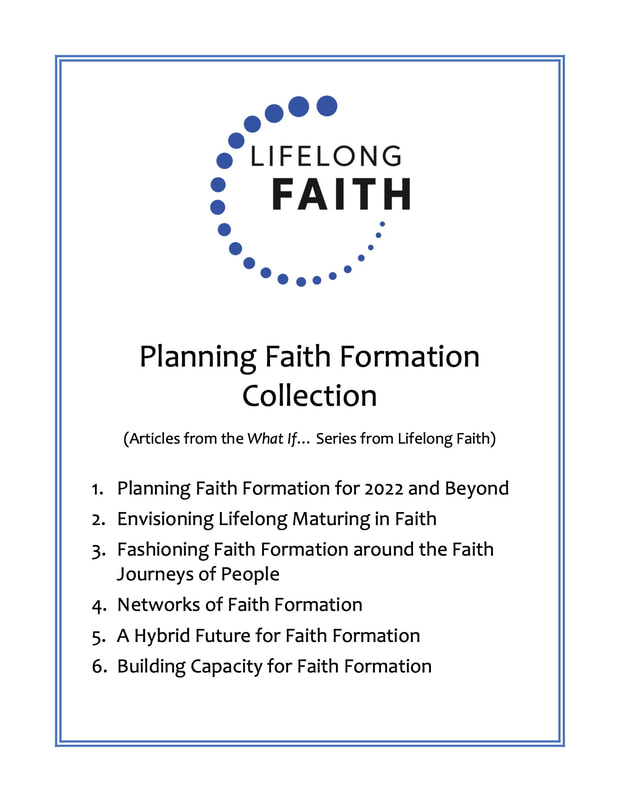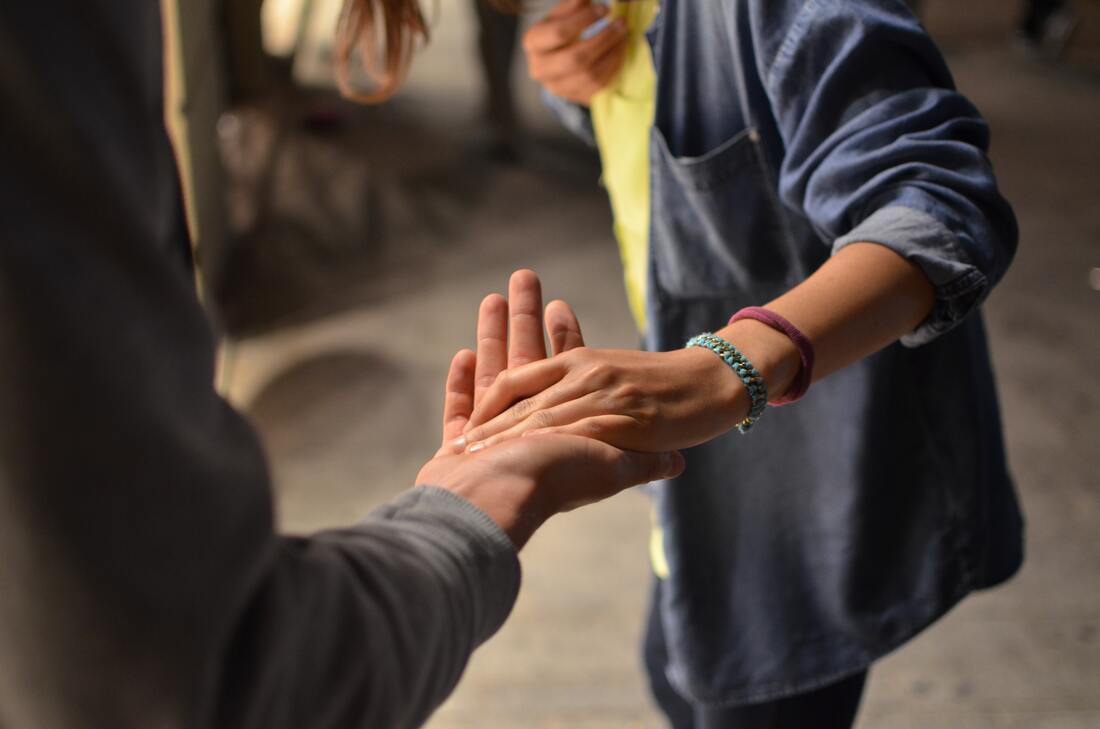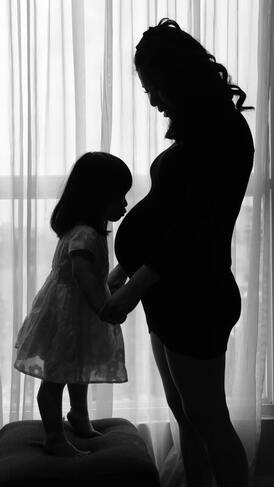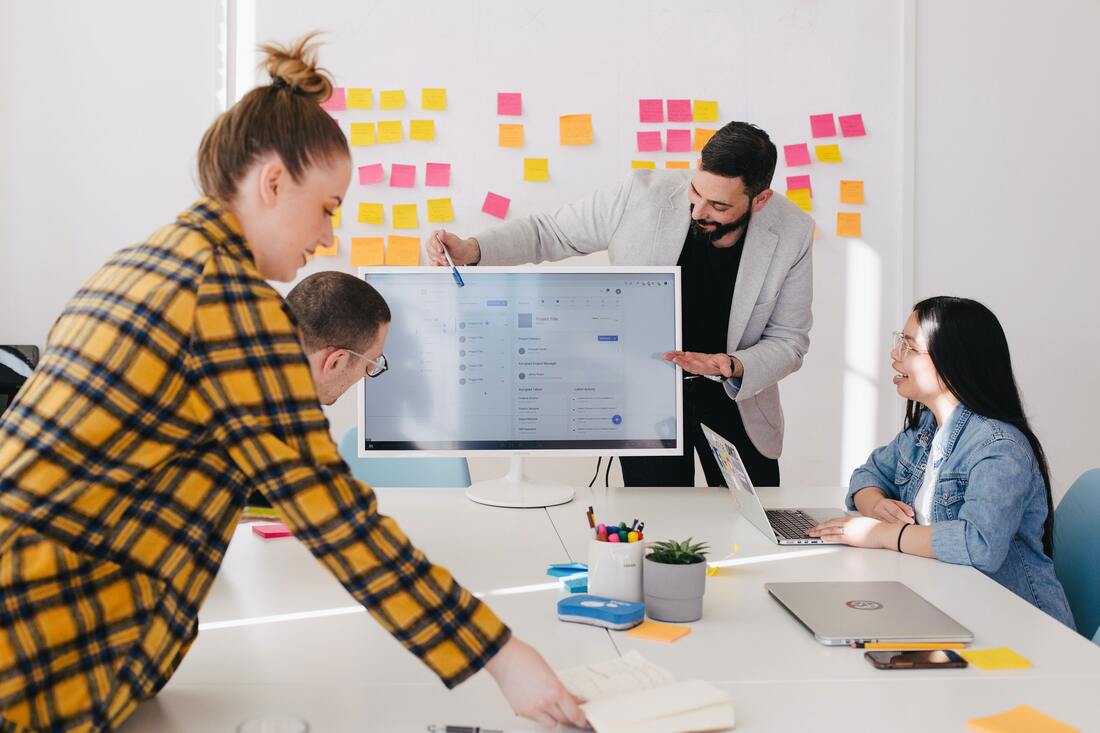New: Three Collections of Lifelong Faith Articles
In 2021 and 2022 I wrote a series of articles on lifelong learning and faith formation, on planning faith formation, and on the importance of Christian practices for all ages and generations. I have organized the articles into three collections to make it easy to use and download.
|
|
| ||||||||||||||||||
Planning Faith Formation for 2022 and Beyond
A Time for Creativity, Experimentation, Innovation
|
This Guide to planning faith formation helps you think systemically about what we need to do in faith formation to address the challenges of today. The Guide suggests three perspectives to guide planning: #1. Think Systemically about Faith Formation, #2. Plan in a Three-Year Timeframe, and #3. Build Capacity. The Guide presents five examples of systems-level suggestions for creating faith formation that addresses the big challenges we face today:
Download and read the article in PDF.
| |||||||
We Need to Become System Thinkers How can a lifelong and life-wide approach to faith formation provide a systemic response to addressing the challenges of religious change and post-pandemic life?
Systems thinking is a way of helping us view a church’s faith forming systems from a broad perspective that includes seeing the whole life span and the context of people’s lives today, rather than seeing only specific issues or concerns (e.g., we’ve got to solve the youth problem). By focusing on the entire system of faith formation, we can attempt to identify solutions that address as many problems as possible in the system. The positive effect of those solutions leverages improvement throughout the system. Thus, they are called “leverage points” in the system. This priority on the entire system and its leverage points is called whole systems thinking. Download and read the article in PDF.
| |||||||
Networks of Lifelong Learning – Parts One & TwoWe live in the age of networks. We are all part of networks—families, schools, workplaces, religious congregations, social circles, and more. Networks— collections of people (and their resources) connected to each other through relationships—aren’t new. They are as old as human society. Over the past two decades, facilitated by digital technology and tools, societies have become more connected. Network thinking and design now permeate social life. Increasingly education is being viewed and designed as a network of learning resources— people, experiences, content, activities, and more—fashioned around the learning needs of people.
We now have the ability to construct our own networks of learning, utilizing a variety of new technologies and the abundance of high-quality print, audio, video, and online resources that are readily available to us. Learning networks not only provide access to a virtually endless array of opportunities that also offer us multiple points of entry, providing individualized pathways of learning and faith growth. How can lifelong faith formation be developed as a network of learning for all ages and generations? Read the Two- Part Article Online. Download the Articles in PDF.
| |||||||||||||
Becoming a Center of Lifelong LearningRead the following description of what one organization does. Can you name the organization that I’m describing?
Did you figure it out? Read the Article Online. Download the Article in PDF.
| |||||||
Fashioning Faith Formation around the Faith Journeys of People - Part One & Part TwoYou may be thinking that the title of this article is stating the obvious: Isn’t all faith formation fashioned around the faith journeys of people? To fashion faith formation around the faith journeys of people means putting people at the center of all that we do. It means addressing the actual lives of people—their struggles and joys, needs and hungers, life tasks and issues, social and cultural context, and more. It means addressing the diversity of their spiritual and religious commitments, engagements, and practices. There are churches that have made this vision the guiding light for all of their faith formation practice. Unfortunately, this is not the common practice.
Part Two of the article provides a practical process and examples for personalizing faith formation. Read the Part One and Part Two Articles Online. Download the Part One and Part Two Articles in PDF.
| |||||||||||||||
How People Learn TodayAn important element of embracing a lifelong learning paradigm is to design faith formation experiences that reflect our best understanding of how people of all ages learn. Over the last twenty years we have been blessed with substantive research on how learning happens and how people learn best. In a recent study, How People Learn II: Learners, Contexts, and Cultures (2018), The National Academies of Sciences, Engineering, and Medicine updated their 2000 report with new research and conclusions. This article presents the major conclusions of the study organized into the following categories: 1) The Influence of Culture, 2) Types and Processes of Learning, 3) Knowledge and Reasoning, 4) Motivation to Learn, 5) Implications for Learning, 6) Learning Technology, and 7) Learning across the Life Span.
Read the Article Online. Download the Article in PDF.
| |||||||
Envisioning Lifelong Maturing in Faith
The shift to a lifelong faith formation paradigm in churches begins with a vision of maturing in Christian faith. In order to develop a lifelong paradigm a church needs of lifelong vision of faith maturing that can guide its practice of faith formation. I would suggest that this vision be expressed through goals for maturing in faith that apply to the whole life span. Faith formation in each stage or season of life would be guided by one vision of faith maturing expressed through specific goals and life stage appropriate faith formation.
Read the Article Online. Download the Article in PDF.
| |||||||
Embracing a Lifelong Learning Paradigm
The paradigm of education has shifted over the last several decades. Most fundamentally it has moved from an instructional, schooling paradigm focused primarily on children and youth in age-graded classroom settings to a lifelong learning paradigm focused on people learning in a diversity of settings for the whole of life.
I believe that the shift to a lifelong faith formation paradigm can enable churches to become centers of lifelong learning for every season of life from young children through older adults—providing a way to engage people in learning and practicing their faith at every stage of life. This if the first of a series of What If. . . articles that will to explore how to make the paradigm shift to lifelong faith formation for churches who are just beginning the journey, and how to enhance and expand the shift among churches who have already begun. Read the Article Online. Download the Article in PDF.
| |||||||
Building Capacity for Faith FormationOne of the essential roles of all pastoral leaders today is to develop the mindset, the processes, and the skills for becoming capacity builders. Capacity building is designed to improve and enhance the church’s ability to achieve its mission and sustain itself over time. Among the essential capacities needed in churches today are leadership (professional and volunteer), financial sustainability, facilities, communication, technology, collaborations with other churches and community organizations, and programmatic resources in all forms—print, audio, video, digital, and online. This article explores how to develop a capacity-building mindset and two essential skills for building capacity for faith formation: curating resources and developing leaders.
Read the Article Online Download the Article in PDF. Use the Word file for adapting the worksheets.
| |||||||||||||||
How Shall We Live Now? – Part Five
| |||||||
| 5-3_what_if_article_-_how_shall_we_live_-_part_5.pdf | |
| File Size: | 459 kb |
| File Type: | |
How Shall We Live Now? – Part Four
| |||||||
| 4-26 What If - How Shall We live - Part 4.pdf | |
| File Size: | 296 kb |
| File Type: | |
How Shall We Live Now? - Part Three
| |||||||
| 4-19 What If - How Shall We Live - Part 3.pdf | |
| File Size: | 332 kb |
| File Type: | |
How Shall We Live Now? - Part Two
| |||||||
| 4-11 What If - How Shall We Live - Part 2.pdf | |
| File Size: | 325 kb |
| File Type: | |
How Shall We Live Now? - Part OneI believe that faith formation (and the whole church) in the emerging post-pandemic world will need to help people of all ages answer the question “How shall we live now?” The pandemic has disrupted our lives in ways that we have only begun to name. We are searching anew for meaning and purpose – now in a post-pandemic world. We are trying to process our losses and the grief that brings. We are struggling to build a world of justice, peace, care for creation, and respect for the dignity of all people. We are starting to rebuild our network of relationships and our resiliency as families and communities. We are all looking to answer the question, “How shall we live now?” in a post-pandemic world. What are the approaches, resources, people, and wisdom we need to address this question?
Read the Article Online Download the Article
| |||||||
Becoming “Anticipators of the Future”We need to develop the mindset and skill of anticipating. We need to become “anticipators of the future”—embracing a role as keen observers of what is happening in our communities and churches—imagining in advance what shape life will take as the pandemic winds down and a new way of life emerges, and planning to take action. I am practicing being an “anticipator” by listening to the pandemic experiences and questions of a wide spectrum of people, including colleagues, pastors, faith formation leaders. I’ve been watching and reading some of the best thinking on post-pandemic life and what this new life will mean for individuals, families, and communities. I’ve started my own list of “anticipations” for the future of church and faith formation to guide my thinking. Here are my five anticipations (in no particular order):
Read the Article Online Download the Article
| |||||||
|
March 15, 2021
|
Learning from Faith Formation during the Pandemic: Reflection and EvaluationThere’s much to be learned from your pandemic creativity and innovations. Many of the new approaches you launched—at home faith formation, digital methods and media, online learning, to name a few—can become permanent features of faith formation in your church for years to come.
Now is a good time to reflect and evaluate while everyone’s experience is still fresh. This is the time to capture your personal learning and engage all those participating in faith formation in sharing their stories and experiences. This article presents three types of evaluation: Personal, Team, and Participant. I have created worksheets for each of the three types of evaluation that can be easily adapted for your church and setting. Read the Article Online Download the Article
| ||||||||||||
|
March 1, 2021
|
A Vision for Maturing in FaithThis article proposes ten goals for maturing in faith that can guide the development of faith formation at each stage of life so that we can (re)direct our attention to people growing in faith and discipleship. Guided by the ten goals we can ask what we need to be doing to help faith and discipleship flourish in the lives of our people from childhood through older adulthood.
| ||||||
|
February 1, 2021
|
New Approaches to Faith Formation in the Midst of the PandemicWhat are we discovering and learning about faith formation, about our community, and about ourselves during these long months of the pandemic?
Read the Article Online Download the Article
| ||||||
|
Photo by You X Ventures on Unsplash
February 8, 2021
|
Planning Faith Formation in a Post-Pandemic World
How do we plan a new future for faith formation that addresses the adaptive challenge of recognizing the changing conditions caused by the pandemic and then designing creative and innovative initiatives to respond to people's lives today.
Read the Article Online Download the Article and the Research Guide
| ||||||||||||
|
February 15, 2021
|
Creating Innovation in Faith Formation
This article explores how to create innovation in faith formation by presenting two types of innovation, strategies for continuing to innovate, and five suggestions for moving forward with innovation into the future.
Read the Article Online Download the Article and the "Switch Workbook"
| ||||||||||||
|
Photo by Brooke Cagle on Unsplash
February 22, 2021
|
A Hybrid Future for Faith FormationI believe the future of faith formation is hybrid. Hybrid models hold together two important values in faith formation: the importance of in-person relationships and faith forming experiences, and the importance of being responsive to the complexity of people’s lives and their religious-spiritual needs. Hybrid models expand faith formation opportunities for everyone.
| ||||||



























